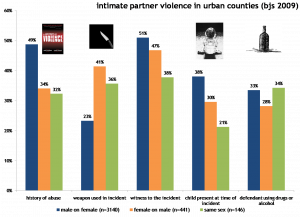Erica Smith and Donald Farole of the Bureau of Justice Statistics just released a new report on domestic or intimate partner violence (IPV). The sample is based on 3,750 cases filed in 16 large urban counties in May 2002.
When I present on IPV in classes, I’m occasionally asked about differences by gender and sexual preference. The chart below shows some characteristics of the 3140 cases (84 percent) with male perpetrators and female targets in blue, the 441 cases (12 percent) with female perpetrators and male targets in orange, and the 146 same-sex cases (4 percent) in green. [I suspect they didn’t distinguish male-male from female-female because the numbers were getting small.]
Some of the differences seem large to me. First, about half of all male-on-female dyads involve a prior history of abuse, relative to 34 percent of female-on-male dyads and 32 percent of same-sex dyads. Second, female-on-male and same-sex cases are far more likely to involve a weapon than male-on-female cases. Contrary to the old idea that a man must be stabbed before a woman will be arrested for IPV, however, only 41 percent of female-on-male IPV cases involved a weapon. Third, there are no other witnesses at all in most same-sex IPV cases, but there is a child present in 38 percent of male-on-female cases. Finally, regardless of sex or sexual orientation, the perpetrator was using alcohol or drugs in about one-third of the IPV cases. [Since that last number seems a bit low to me, I’d check how it was measured before citing it].
See the report or the source data for more information.


Comments 1
Verlinkenswertes (KW48/09) | Criminologia — November 29, 2009
[...] BJS report on intimate partner violence in urban counties (Public Criminology, 27.11.2009) [...]